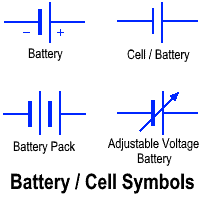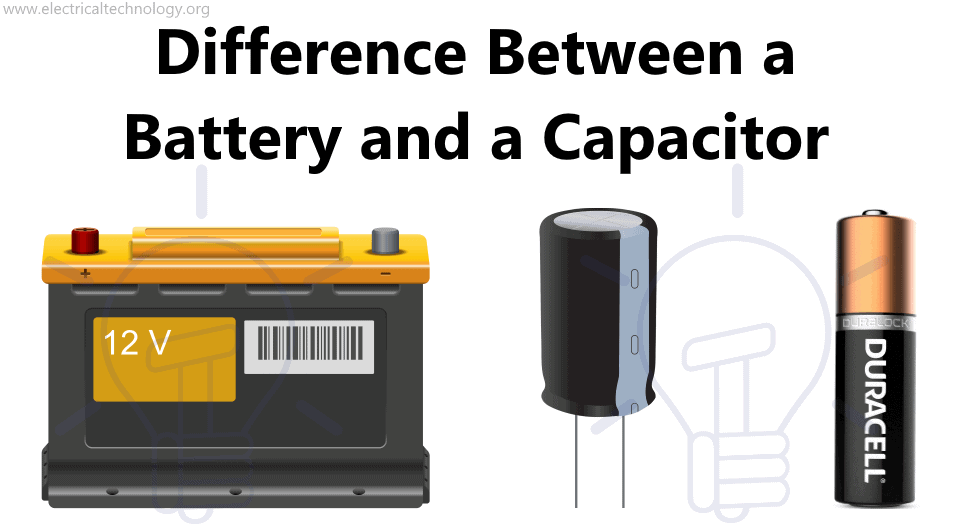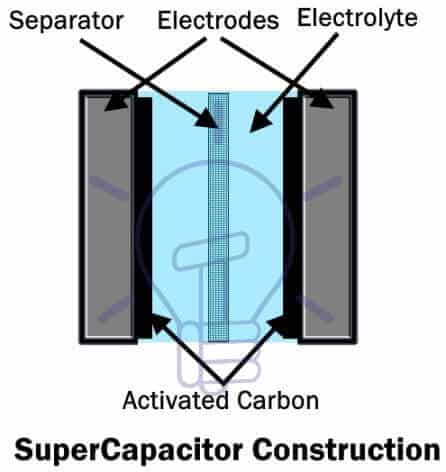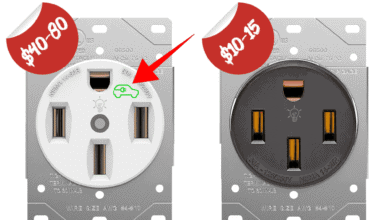Difference Between a Battery and a Capacitor
What is the Main Difference Between Battery and Capacitor?
A Battery and a Capacitor is similar as both store and release the electrical energy and rated in Ah. But, there are some key differences between them which has been discussed in the following post. The main difference between a battery and a capacitor is that Battery stores charge in the form of chemical energy and convert to the electrical energy whereas, capacitor stores charge in the form of electrostatic field.
- Related Post: Difference Between Capacitor and Supercapacitor
Battery
A Battery is a device used as source of energy. It has three main parts known as Cathode (Positive Terminal), Anode (Negative Terminal) and a separator known as electrolyte. Battery store energy in the form of chemicals and convert it back to the electrical energy when needed. The chemical reaction called oxidation-reduction takes place in between the cathode and the anode via the separator (electrolyte) during charging and discharging of the battery.
- Related Post: Difference Between Relay and Circuit Breaker
Capacitor
A Capacitor is a two terminal device having two or more parallel layers plates separated by a dielectric medium known as insulator. When voltage applied across the plates of capacitor, current want to flow through it until the voltage across both the negative and positive (Anode and Cathode) plates become equal to the applied voltage (source). The insulating medium in between the two conductive plates of capacitor opposes to the flow of current. This change create an effect which stores in capacitor in the form of electrostatic field.
- Related Post: Difference between Contactor and Starter
Supercapacitor
A supercapacitor is also known as Super Cap or Ultra-Capacitor. It is a type of polar capacitor with high capacitance rating but has low voltage rating. Supercapacitor capacitance ranges from 100 F to 12000 F with low voltage ratings approximately 2.5 v to 2.7 v.
Supercapacitor is supposed to be in between a Capacitor and battery. These types of capacitors charge much faster than a battery and charge more than an electrolytic capacitor per volume unit. That is why a supercapacitor is considered between a battery and an electrolytic capacitor.
- Related Post: Difference between Fuse and Circuit Breaker
Main Differences Between a Battery and a Capacitor
The following table shows key differences and comparison between capacitors and batteries.
| Characteristics | Battery | Capacitor |
| Symbol |  |
 |
| Definition | Battery stores potential energy in the form of chemical energy which is later converted to the electric energy. | A Capacitor stores the potential energy in the form of eclectic field (electrostatic field) and release to the circuit as electric energy. |
| Construction | Battery has three parts known as Cathode (positive (+ve), Anode (Negative (-ve) and Separator (known as electrolyte). | Capacitor is a simple two terminal device Terminals are metallic plates and there is a dielectric material (insulator) between them. |
| Function | Batteries provide energy to the connected circuits. i.e. Battery generates electrons and charge. | Capacitors draw, store and release the energy. i.e. Capacitor only stores charged electrons. |
| Working Principle | Battery works based on chemical reaction called oxidation-reduction reaction. | When voltage applied across the capacitor terminals, It starts to store energy in it. |
| Operation | Battery Generate Electrons. | Capacitor Store Electrons. |
| Types | Battery types are Alkaline, Lithium Cells, Silver Oxide Cells, Zinc Air Cells, Zinc Carbon, Lead Acid, Lithium Ion (Li-ion), Nickel Metal Hydride (Ni-MH), Nickel Cadmium (Ni-Cd) etc. | Electrolytic, Electrostatic, Electrostatic, Electrochemical, Super Capacitor, Hybrid Super Capacitors, Ceramic Capacitors, Film Capacitors, Tantalum, Integrated Capacitor. |
| Type of Device | Battery is an Active Component. | Capacitor is a Passive Component. |
| AC & DC Usage | Battery is used to provide DC supply. | Capacitor blocks DC supply and pass the AC supply. |
| Voltage Behavior | A battery provides almost constant voltage while discharging. | A Capacitor discharging voltage quickly decreased. i.e. discharge rate is very fast. |
| Potential Difference (P.d) | Constant | Increases exponentially |
| Charging and Discharging | The Charging and Discharging time of a Battery is slow i.e. 10 – 60+ minutes. | Charging and Discharging time of a Capacitor is very fast i.e. 1-10 seconds. |
| Charging Temperature | 0 – 45 °C (32 – 113°F) | -40 to 65 °C (-40 – 149°F) |
| Life Cycle | 500+ Hours | 1M – 3M hours. |
| Service Life | 5-10 Years | 10-15 Years |
| Voltage per Cell | 3.6-3.7 Volts | 2.3 – 2.75 Volts. |
| Specific Power Rating | Battery Specific power rating is about 1k – 3k (W/kg). | Capacitor Specific power rating is about 1M (W/kg). |
| Polarity | Battery polarity reversed during charging and discharging. | Capacitor polarity must be same during charging and discharging. |
| Size | For the same charging capacity, Battery size is small as compared to a capacitor. | Capacitor size is large as compared to a battery for same capacity rating. |
| Cost | Cost of Battery is higher. | Cost of Capacitor is Less. |
| Advantages |
|
|
| Disadvantages |
|
|
| Applications |
|
|
Related Posts:
- Difference Between MCB, MCCB, ELCB & RCB, RCD or RCCB Circuit Breakers
- Difference between AC and DC Resistance & How to calculate it?
- Difference between Star and Delta Connections – Comparison Of Y/Δ
- Difference between Circuit Breaker and Isolator / Disconnector









How to design an electronic circuit from a given differential equation or other mathematical equation as if necessary from a matrix or a set of linear or nonlinear set of equations. thank you. as an example an oscillator like an RLC circuit it can be represented by a second order differential equation where we can see all its characteristics exactely.
best comparison described..